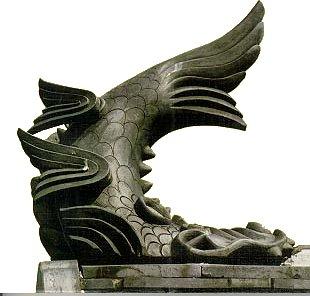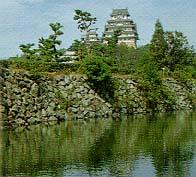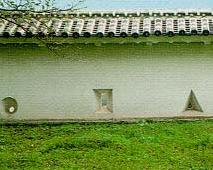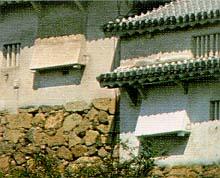 |

 |
After the end of the Sengoku Period, which was characterized by many wars between local lords, castles began to have an added function that of serving as the center of government. Defense was not the sole function. The construc-tion of castles began to flourish, and numerous castles were built throughout Japan. During this castle building period, the present looking Himeji Castle was built. It was one of the castles of primary importance to the Shogun, hence Himeji Castle was intended to show to the independent lords of Western Japan the power and influence of the lord of Himeji Castle. In its use as the center of government, as a fortress, and as an exhibition of power, Himeji Castle is one of the best examples. Of all the castles built during the time that Himeji Castle was built, Himeji Castle is the only one that has retained the atmosphere of the original castle.
From the standpoint of esthetically pleasing architecture, Himeji Castle marks an epoch of Japanese architecture. The five-storied main donjon together with the three smaller donjons one on the east, one on the west, and one on the northwest forms a magnificent shape which gives the effect, from any viewpoint, of a lovely white heron ready to fly into the blue sky. There are two styles of gables, peaked and undulating, and two styles of windows, square and bell-shaped, and their placement has added to the beautiful harmony of the entire structure. Himeji Castle is a magnificent example of the peak of castle architecture in Japan.
Devices for Defense
 |
When building a castle, one must consider the importance of using the natural resources of the vicinity and the proper placement of the buildings. According to geography, castles may be classified into three types: mountain castles, hill castles, and plains castles. Himeji Castle is a hill castle. The placement of the moat, the stone wall of defense, the gate, and the buildings themselves is called the nawabari; and the nawabari determines the fate of the castle. Himeji Castle had an inner moat, a middle moat, and an outer moat which gave it a three fold line of defense. Inside the inner moat, the only moat that can be presently seen, the nawabari was minutely designed to prevent the enemy intruders from entering the donjons. Therefore, Himeji Castle can be said to be an excellent castle from the standpoint of defense.
Gates
 |
The gate shut off the road and played an important role in strengthening the defense of the castle. There were many kinds of gates. The entrance gates were large, strong, and imposing, but the gates near the donjon were small and very strong. Not many people at one time could enter a gate near a donjon.
Moats and Walls
 |
Moats were the first line of defense. Himeji Castle originally had three moats: an inner, a middle, and an outer moat. The moats were always kept full of water to prevent the enemy from crossing. Stone walls also played an important defensive part. According to the nawabari, different sizes and strengths of walls were built for a variety of aims and defense.
Other Means of Defense
Sama
 |
A SAMA is a hole, either a circle, rectangle, triangle, or square, built into the wall so that a gun or an arrow could be shot through the hole at the enemy. Many such holes were built into the walls. The rectangular holes were for use by the archers, whereas guns were shot through the circle, square, or triangle.
The Ishiotoshi
 |
ISHIOTOSHI was an opening through which stones could be thrown or boiling water poured to prevent the enemy from scaling the wall. Many such openings were strategically placed. In the donjon they were placed on the first floor in the walls that overlooked great heights. They were also placed in the outer walls of the corridors that connected the turrets.
